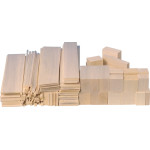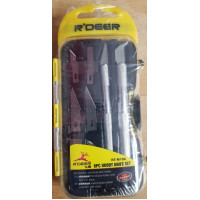Balsa wood

Largest stockist of Balsa wood in KZN
some interesting facts about Balsa wood
Balsa lumber is very soft and light, with a coarse, open grain. The density of dry balsa wood ranges from 40–340 kg/m3 (2.5–21.2 lb/cu ft), with a typical density of about 160 kg/m3(10 lb/cu ft).[6] The wood of the living tree has large cells that are filled with water. This gives the wood a spongy texture. It also makes the wood of the living tree not much lighter than water and barely able to float. For commercial production, the wood is kiln-dried for about two weeks, leaving the cells hollow and empty. The large volume-to-surface ratio of the resulting thin-walled empty cells gives the dried wood a large strength-to-weight ratio because the cells are mostly air. Unlike naturally rotted wood, which soon disintegrates in the rainforests where balsa trees grow, the cell walls of kiln-seasoned balsa wood retain their strong structure of cellulose and lignin.[7]
Because it is low-density but high in strength, balsa is a very popular material for light, stiff structures in model bridge tests, model buildings, and for the construction of model aircraft; all grades are usable for airworthy control line and radio-controlled aircraft varieties of the aeromodeling sports, with the lightest "contest grades" especially valuable for free flight model aircraft. However, it also is valued as a component of full-sized light wooden aeroplanes, most notably the World War II de Havilland Mosquito.[7]
Balsa is used to make wooden crankbaits for fishing, especially Rapala lures.
Sticks of dried balsa are useful as makeshift pens for calligraphy when commercial metal nibs of the desired width are not available.
Balsa wood is often used as a core material in composites; for example, the blades of many wind turbines are partly of balsa. In table tennis bats, a balsa layer is typically sandwiched between two pieces of thin plywoodmade from other species of wood. Balsa wood is also used in laminates together with glass-reinforced plastic (fiberglass) for making high-quality balsa surfboards and for the decks and topsides of many types of boats, especially pleasure craft of less than 30 m (98 ft) in length.
Balsa - Precision Knife
Sharp knife used for cutting / trimming balsa and other materials. comes with a handy hard cover whi..
R79.00 Ex Tax: R68.70
Balsa Knife
Sharp knife used for cutting / trimming balsa and other materials. comes with a handy hard cover whi..
R137.00 Ex Tax: R119.13
Balsa Knife - Spare blades ( pk 10)
Spare blades - pack of 10 blades for std balsa knivesSharp knife used for cutting / trimming balsa a..
R98.00 Ex Tax: R85.22
Balsa Knife set
Balsa Knife set - 2 knives with an assortment of blades ued for cutting / trimming balsa and other m..
R183.00 Ex Tax: R159.13
Balsa sheet - 3.0mm ( SECONDS)
Please note this is second grade balsa sheeting, still good quality but varied weights, colour sh..
R25.00 Ex Tax: R21.74
Balsa sheet - 4.0mm ( SECONDS)
Please note this is second grade balsa sheeting, still good quality but varied weights, colour sh..
R28.00 Ex Tax: R24.35
Balsa Square - 6,5mm x 6,5mm
Balsa Square - 6,5mm x 6,5mm 90deg - excellent for building and supporting joints - 900mm long ea..
R16.00 Ex Tax: R13.91














-200x200.jpg)




